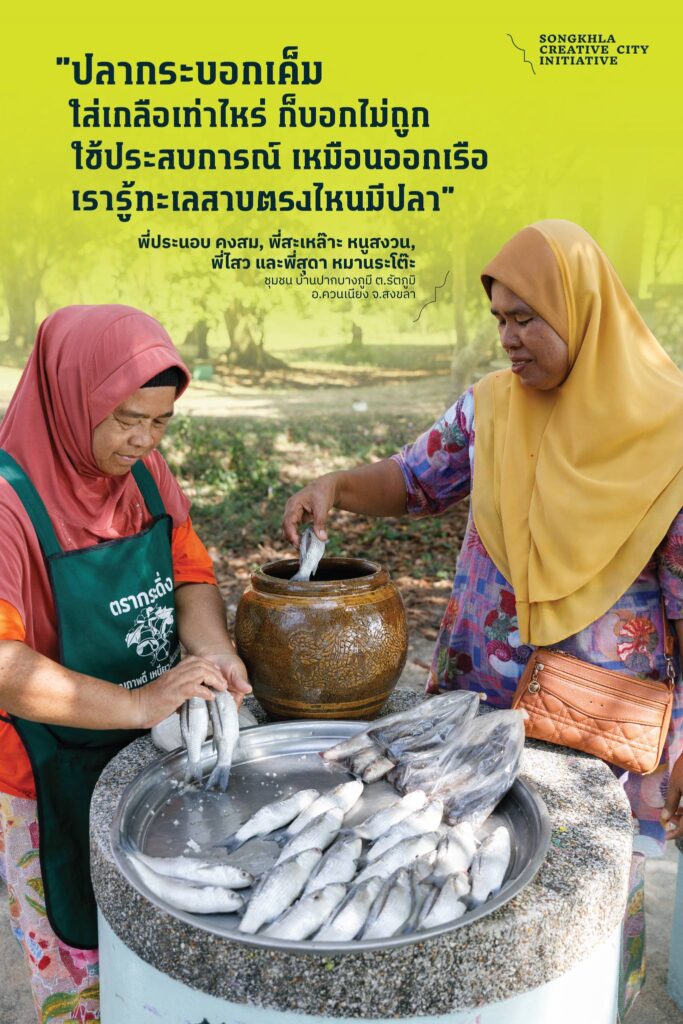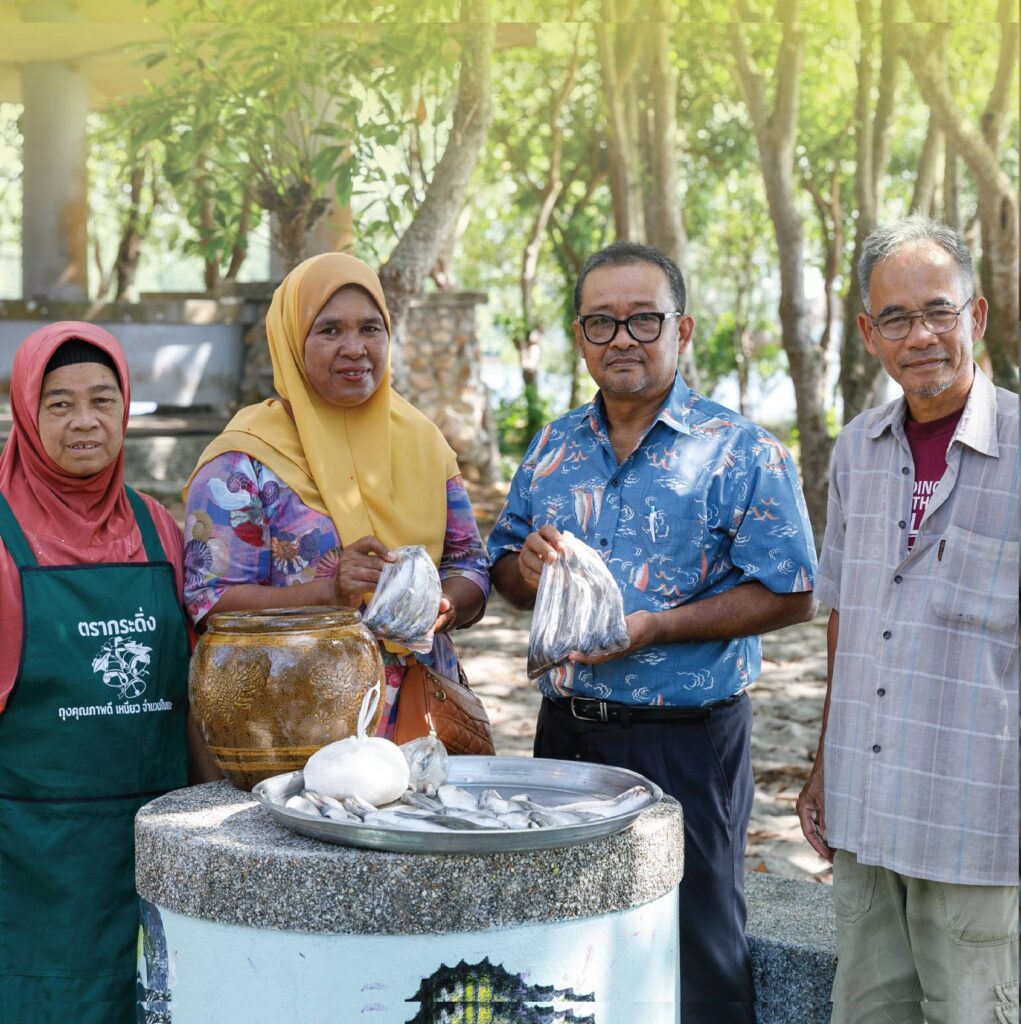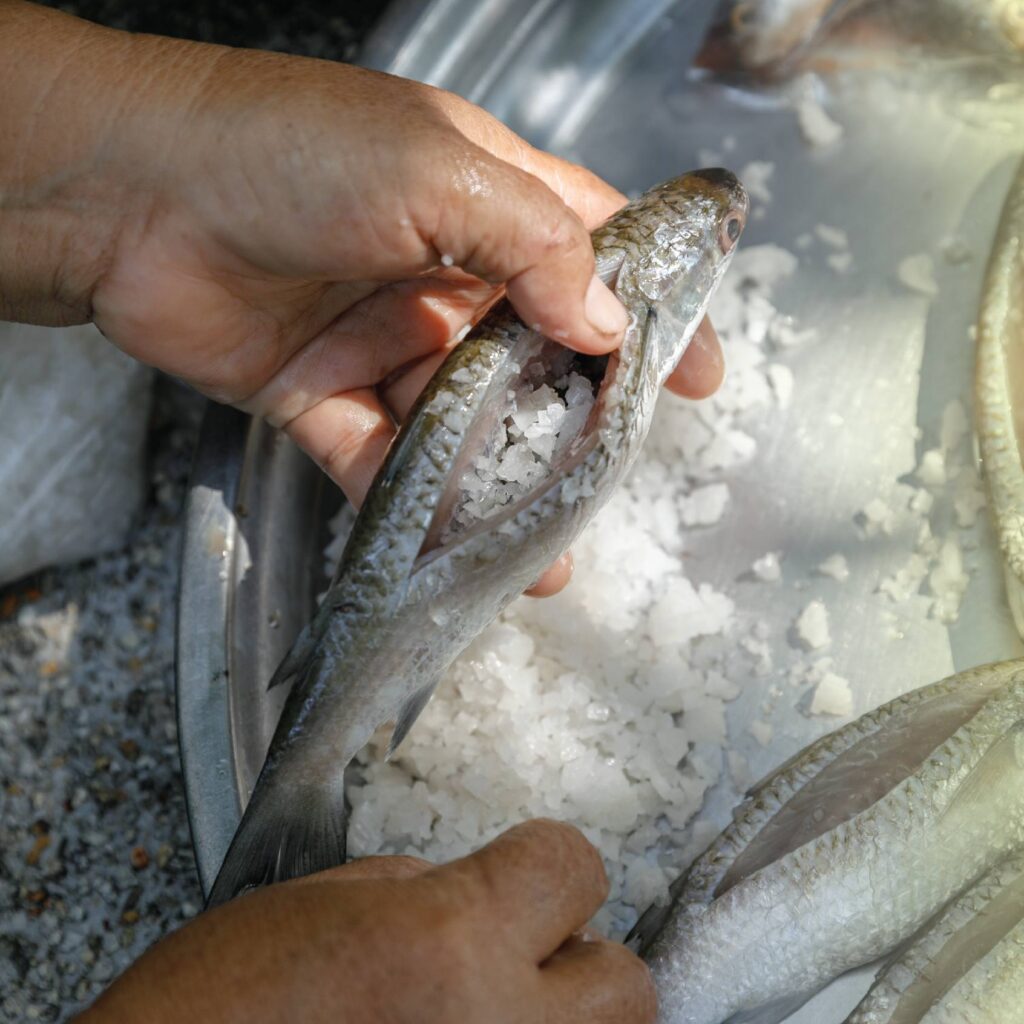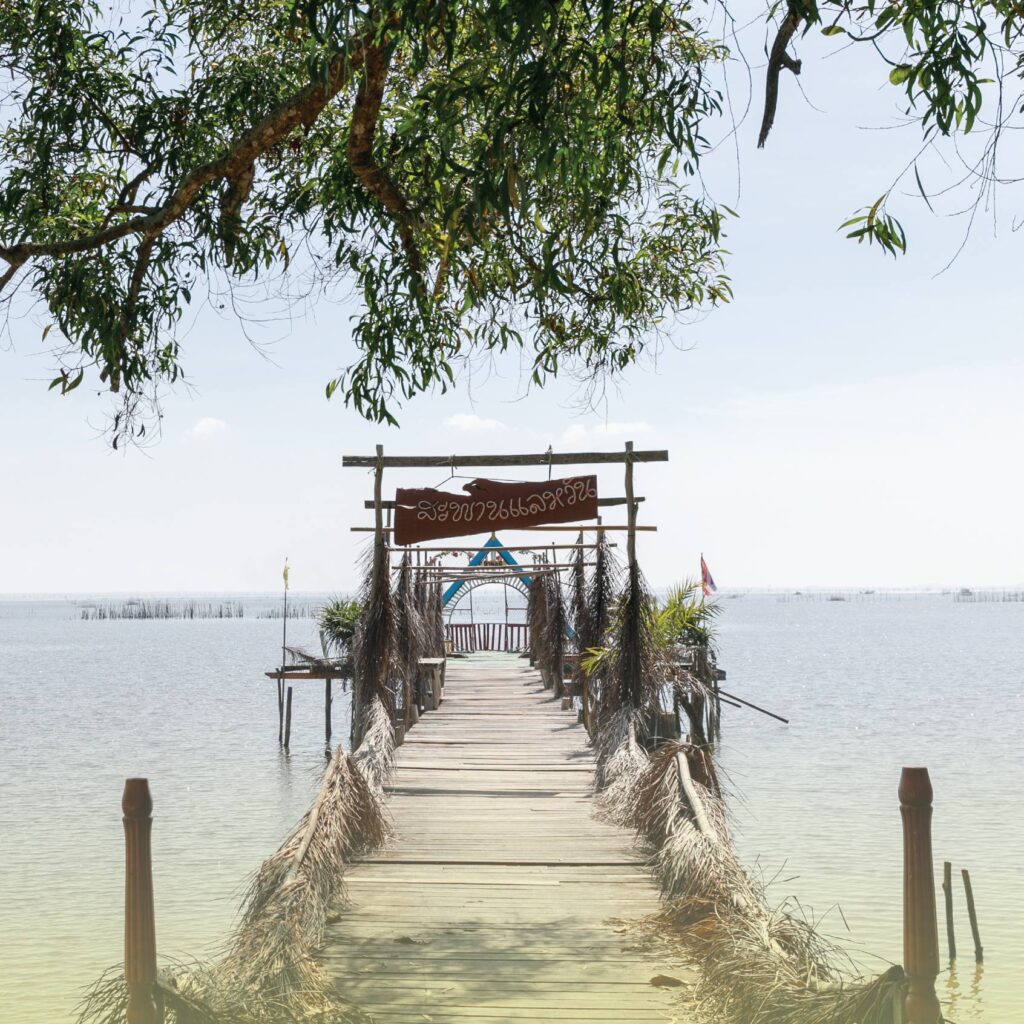– ปลากระบอกเค็ม ถึงวิถีชุมชนประมงชายฝั่ง –
บทสัมภาษณ์ตัวแทนชาวชุมชนบ้านปากบางภูมี ต.รัตภูมิ อ.ควนเนียง จ.สงขลา
“ปลากระบอกเค็ม ใส่เกลือเท่าไหร่ก็บอกไม่ถูก ใช้ประสบการณ์ เหมือนออกเรือ เรารู้ทะเลสาบตรงไหนมีปลา”

ประมงชายฝั่ง คือวิถีหาอยู่หากินของชาวบ้านริมทะเลมาช้านาน ตัวแทนชาวบ้านที่หมู่ 3 บ้านปากบางภูมี ได้แก่ พี่ประนอบ คงสม ผู้นำขบวนองค์กรชุมชนจังหวัดสงขลา, พี่สะเหล๊าะ หนูสงวน, พี่ไสว และพี่สุดา หมานระโต๊ะ – ภูมิใจบอกเล่าเรื่องราววิถีชีวิต ผ่านเมนู ‘ปลากระบอกเค็ม’ ภูมิปัญญาการถนอนอาหารพื้นบ้านที่อร่อยถูกปาก และกำลังได้รับการผลักดันโดยขบวนองค์กรชุมชน ให้เป็นสินค้าสร้างรายได้เสริมให้กับพี่น้องประมงชายฝั่ง
__
![]() “นี่คือเมนูเด็ดเลยนะ นึกถึงพี่น้องอีสานเขามีแหนม มีปลาร้า กินกับข้าวเหนียว กินแล้วมีแรงทำงาน เราก็มีปลากระบอกเค็มนี่แหละ จะทอดน้ำมัน หรือยำใส่พริกใส่มะนาว หรือจะหมกใบตองย่างไฟอ่อนๆ ก็ได้อันนี้เวลาสุกจะหอมฉุย กินข้าวร้อนๆ อร่อยมาก เติมข้าวจนลืมตัวเลยแหละ” พี่ประนอบ เกริ่นนำให้เพื่อชวนเราดูปลากระบอกขาว ขนาดยาวประมาณฝ่ามือ มีแถบสีเงินข้างตัวกระทบแสง ครีบและตายังใสบอกถึงความสดใหม่
“นี่คือเมนูเด็ดเลยนะ นึกถึงพี่น้องอีสานเขามีแหนม มีปลาร้า กินกับข้าวเหนียว กินแล้วมีแรงทำงาน เราก็มีปลากระบอกเค็มนี่แหละ จะทอดน้ำมัน หรือยำใส่พริกใส่มะนาว หรือจะหมกใบตองย่างไฟอ่อนๆ ก็ได้อันนี้เวลาสุกจะหอมฉุย กินข้าวร้อนๆ อร่อยมาก เติมข้าวจนลืมตัวเลยแหละ” พี่ประนอบ เกริ่นนำให้เพื่อชวนเราดูปลากระบอกขาว ขนาดยาวประมาณฝ่ามือ มีแถบสีเงินข้างตัวกระทบแสง ครีบและตายังใสบอกถึงความสดใหม่
อย่างที่เราทราบกันดีว่ากำเนิดของภูมิปัญญาการถนอมอาหาร เหตุผลหนีไม่พ้น เพราะวัตถุดิบนั้น ๆ หาได้มากจนชุมชนกินกันไม่ทัน ต้องหาสารพัดวิธีเก็บรักษาไม่ให้เสียของ
เมนู ‘ปลากระบอกเค็ม’ มาด้วยเหตุผลนี้ แถมยังเป็นของดีของอร่อยติดครัว สร้างรายได้เสริมช่วงนอกฤดูหาปลา โดยเฉพาะที่บ้านปากบางภูมี ชุมชนที่ถือว่าเป็นเบอร์ต้นๆ ในการจัดส่งปลากระบอกขาว และปลากระบอกเค็มออกสู่ตลาด
__
![]() “แถวนี้เรียกว่า ‘บาง’ คือชุมชนปากน้ำ มีคลองภูมี พาน้ำจืดจากน้ำตกบริพัตรไหลลงไปทะเลสาบสงขลา สวนตรงนี้เรียกว่าหาดปากบางภูมี เป็นแหล่งท่องเที่ยวขึ้นชื่อของตำบล ความที่พื้นที่เป็นแบบนี้ จึงมีทั้งน้ำจืด น้ำกร่อย และน้ำทะเล มีป่าชายเลน และมีหาดกว้าง เป็นพื้นที่เหมาะสำหรับให้สัตว์น้ำมาเติบโต
“แถวนี้เรียกว่า ‘บาง’ คือชุมชนปากน้ำ มีคลองภูมี พาน้ำจืดจากน้ำตกบริพัตรไหลลงไปทะเลสาบสงขลา สวนตรงนี้เรียกว่าหาดปากบางภูมี เป็นแหล่งท่องเที่ยวขึ้นชื่อของตำบล ความที่พื้นที่เป็นแบบนี้ จึงมีทั้งน้ำจืด น้ำกร่อย และน้ำทะเล มีป่าชายเลน และมีหาดกว้าง เป็นพื้นที่เหมาะสำหรับให้สัตว์น้ำมาเติบโต
หมู่บ้านเราอยู่ตรงนี้น่าจะอยู่มา 100 กว่าปีแล้ว สัก 3-4 ชั่วอายุคน ทุกวันนี้อยู่กันราว ๆ 400 ครัวเรือน ที่อาศัยพึ่งพาความอุดมสมบูรณ์ตรงนี้เลี้ยงครอบครัว
อาชีพของคนที่นี่เมื่อก่อนชาวบ้านจะออกเรือใหญ่ ไปทำประมงในอ่าวไทย เรียกว่าแทบจะทุกบ้านเลยก็ว่าได้ แต่มา 10- 20 ปีหลังมานี้ ไม่ค่อยมีใครไปแล้ว อาชีพหลักจึงเป็นประมงชายฝั่งเป็นหลัก เสริมด้วยงานรับจ้างทั่วไป
วิถีชีวิตของคนที่นี่ บ่ายๆไม่ต้องถามหานะ นู้นเขาไปออกทะเล หรือเช้ามากๆ ถึงช่วง 3 โมง (9โมงเช้า) เขาออกไปเก็บปูปลาตามที่วางดักไว้ จับได้แล้วส่งตลาด ไม่ก็ให้แม่บ้านไปนั่งขาย แบ่งไว้กินบ้าง หรือถ้าได้มากๆ อย่างปลากระบอกตั้งแต่เดือน พฤษภา ถึงสิงหา เราก็เอามาทำเค็ม”
__
พี่ๆ ผู้ชายเล่าให้ฟังพลางชี้มือไปที่หาด ซึ่งเป็นทั้งอู่ข้าวอู่น้ำ และได้รับการส่งเสริมเป็นที่สาธารณะมีไว้พักผ่อนหย่อนใจ และท่องเที่ยว ขณะที่พี่ๆ ผู้หญิงก็เริ่มผ่าหลังปลากระบอก เอาเครื่องในไส้และของเสียออก เก็บแบ่งไส้ขาวเอาไว้ใส่ขวดเก็บไว้ทำไตปลา อีกคนคว้าเกลือเม็ดโตๆ ใส่หลังปลา ก่อนหย่อนเรียงลงหม้อ
__
[ แม่บ้านเล่าเรื่อง – พี่สะเหล๊าะ และพี่สุดา]
![]() “ปลากระบอกที่เราได้จะเป็นปลารุ่นๆ พวกนี้อยู่ใกล้ฝั่ง ช่วงที่น้ำขึ้นน้ำลงจะเห็นขึ้นมาโดดเล่นน้ำ จริงๆ ปลากระบอก เป็นปลาที่หาได้ทั่วไปในทะเลสาบสงขลา ทั้งตอนบน กลาง และล่าง
“ปลากระบอกที่เราได้จะเป็นปลารุ่นๆ พวกนี้อยู่ใกล้ฝั่ง ช่วงที่น้ำขึ้นน้ำลงจะเห็นขึ้นมาโดดเล่นน้ำ จริงๆ ปลากระบอก เป็นปลาที่หาได้ทั่วไปในทะเลสาบสงขลา ทั้งตอนบน กลาง และล่าง
เมนูปลากระบอกเค็ม จึงไม่ได้มีแค่บ้านเรา แถวสิงหนครก็มี แต่รสชาติไม่เหมือนกันนะ คนนอกชิมไม่รู้ แต่เรารู้ (หัวเราะ) เอาง่ายๆ ไปซื้อที่ตลาดเห็นหน้าแม่ค้าไม่คุ้นนี่เดาได้เลยว่า ปลาจากที่อื่น ไม่ก็จะโดนปลาจากอันดามัน รสชาติไม่อร่อย
อย่างปลาบ้านเรา เราก็พูดได้เลยว่า เนื้อจะนิ่มกว่า รสชาติกลมกล่อมกว่า และที่สำคัญพอเอามาทำปลากระบอกเค็ม คือ เรื่องรสชาติ และรสมือที่จะรู้ได้ทันที
ปลากระบอกเค็มบ้านเราไม่ใส่ผงชูรส ใช้เกลือเม็ด ไม่ใช้เกลือป่น แต่ใส่เท่าไหร่บอกไม่ถูก ใช้ประสบการณ์ เหมือนออกเรือเรารู้ทะเลสาบตรงไหนมีปลา ดูยังไงว่าปลาขึ้น จะวางอวนยังไง ฤดูไหนน้ำเป็นอย่างไร
บ้านเราผู้ชายผู้หญิงออกเรือหาปลาได้ทุกคน”
__
สำหรับท่านใดที่สนใจปลากระบอกเค็ม ผลิตภัณฑ์ชุมชน และการขับเคลื่อนงานพัฒนาคุณภาพชีวิตชาวชุมชนจังหวัดสงขลา ติดตามข้อมูลได้ที่ ขบวนองค์กรชุมชนจังหวัดสงขลา ขขบวนองค์กรชุมชนจังหวัดสงขลา
#ปากบางภูมี#ปลากระบอก#ปลากระบอกเค็ม#องค์การบริหารส่วนตำบลรัตภูมิ#อำเภอควนเนียง#ขบวนองค์กรชุมชนจังหวัดสงขลา#สงขลาสู่เมืองสร้างสรรค์#จังหวัดสงขลา#songkhlacreativecityinitiative#องค์การบริหารส่วนจังหวัดสงขลา#โครงการขับเคลื่อนสงขลาสู่เมืองสร้างสรรค์UNESCO



Salted mullet and the ways of coastal fishing communities –
Interview with representatives of Ban Pak Bang Phumi community, Rattaphum Subdistrict, Khuan Niang District, Songkhla Province
“Salted mullet – there is no specific amount of salt to use. It requires experience. Like setting out on a boat, we know where to find fish in the waters.”
Coastal fishing has been a way of life for residents by the sea for time immemorial. Representatives of Village 3, Ban Pak Bang Phumi, including Pi Pranob Kongsom, Leader of the Community Organization Network for Songkhla Province, Pi Salao Nusanguan, Pi Sawai, and Pi Suda Manratho, are proud to tell stories of their way of life, expressed through the dish “salted mullet” – a delicious preserved food based on local wisdom – which is being promoted by a movement of community organizations as a product to generate additional income for coastal fisherman.
“This is a delicious menu. It reminds me of Isaan cuisine – fermented pork and fermented fish eaten with sticky rice. It provides energy for work. Here, we also have salted mullet, which can be fried in oil, tossed in salad with chili and lime, or wrapped in banana leaves and grilled over a gentle fire. Once cooked, the smell is irresistible. Eaten together with hot rice, it’s so delicious you might forget yourself while eating!”
Pi Pranob introduced and invited us to admire the white mullet, about the length of a palm in size. Silver stripes along the side catch the light, while clear fins and eyes indicate freshness.
The origin and reasons for food preservation knowledge is obvious. Ingredients were so plentiful that communities couldn’t eat them all in time. So, various methods of preservation were developed to ensure food didn’t go to waste.
The dish “salted mullet” originated for this very reason. In addition to being a delicious item to have in the kitchen, it also generates extra income during the fishing off-season, especially in the Ban Pak Bang Phumi community, considered to be the leading market supplier of white and salted mullet.
“In the area called “Bang”, in the Paknam community, the Phumi Canal carries freshwater from Boriphat Waterfall to Songkhla Lake. The park here is called “Pak Bang Phumi Beach” and is a famous tourist attraction in the district. The area features freshwater, brackish water and seawater, as well as mangrove forests and wide beaches, providing an ideal environment for marine life.”
“Our village has stood here for over 100 years, perhaps three or four generations. Today, there are around 400 households that rely on the local abundance to support their families.”
“Formerly, the main occupation of residents was fishing on large boats in the Gulf of Thailand. Certainly, almost every household was involved. However, in the last 10-20 years, less people are doing this. Now the main occupation is coastal fishing, supplemented by general contract work.”
The way of life here is such that, in the afternoon, there is no need to ask where anyone is. They head out to sea early in the morning to set traps, around 9AM, and return around 3PM to collect any crabs and fish that have been caught, which are then sent to market or given to be sold by their partners, also keeping some to eat themselves. If a lot is caught, particularly mullet from May to August, we salt it.”
The men pointed at the beach and explained that the village, both a rice and fishing area, has been promoted as a public recreational space for travelers. Meanwhile, the women continued to cut open the mullets, remove the insides and waste, and collect the white roe and place it into bottles to be made into fish paste. Another person packed large crystals of salt onto the back of the fish before placing them into containers.
[Stories from housewives – Pi Salao and Pi Suda]
“The mullet we catch are young fish, close to shore. During high tide, you can see them swimming and playing in the water. Mullet are commonly found in Songkhla Lake, including the shallows, mid and lower depths.”
“So, salted mullet is not found only in our area, but also in Singhanakhon, although the taste is not the same. Outsiders can’t tell the difference in taste, but we can (laughs). It’s easy, just go to the market and if the seller is an unfamiliar face, you can guess the fish is from somewhere else. They might be fish caught in the Andaman Sea, the taste of which is not as delicious.”
“As for our local fish, we can say that the meat is more tender and the taste more mellow. The most important thing with salted mullet is the taste, which is immediately discernible.”
“We do not use MSG in our salted mullet, and only salt crystal, not table salt. But I can’t say exactly how much salt I use, it comes from experience. Like when we head out on a boat, we know where in the lake the fish are located, how to tell if the fish are near the surface, how to set the nets, and the condition of the water based on season.”
“In our village, both men and woman go out on boats to fish.”
For those interested in salted mullet, community products, and promoting work to develop quality of life for Songkhla communities, please follow information provided by Songkhla Province Community Organization Network.